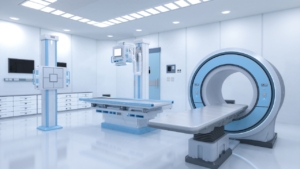Key Takeaways:
- Resource Optimization Importance: Efficient resource management is crucial for ensuring timely and accurate diagnoses, reducing costs, and improving patient satisfaction.
- Alternative Imaging Strategies: Explore options like ultrasound, MRI, and low-dose protocols to reduce reliance on resource-intensive modalities.
- Sustainable Practices: Recycling, energy-efficient equipment, and digital solutions promote environmental responsibility and long-term cost-effectiveness.
- Workflow Optimization: Streamlined workflows, AI integration, and staff training enhance efficiency and maximize resource utilization.
- Collaboration and Innovation: Resource sharing, telemedicine, and investing in research are crucial for overcoming challenges and ensuring continued access to high-quality imaging.
In the healthcare environment, resource management in imaging has become a critical priority for hospitals and diagnostic centers.
With increasing demand for medical imaging efficiency, facilities must adopt alternative imaging strategies and sustainable solutions to manage limited resources effectively.
This blog explores innovative approaches for imaging-resource optimization that can enhance productivity, reduce costs, and maintain high-quality care.
The Importance of Optimizing Imaging Resources
Imaging resource optimization ensures that healthcare facilities can deliver timely and accurate diagnoses without overburdening their equipment or staff.
Inefficient use of resources can lead to increased costs, delayed care, and reduced patient satisfaction.
By embracing alternative imaging strategies, healthcare providers can improve outcomes and enhance operational efficiency.
Alternative Imaging Strategies for Improved Efficiency
Adopting innovative alternative imaging strategies allows facilities to maintain diagnostic capabilities while addressing resource limitations.
Examples of alternative strategies include:
- Expanding Modalities: Utilize modalities like ultrasound and MRI as alternatives to resource-intensive CT scans when appropriate.
- Leveraging Low-Dose Imaging Protocols: Implement protocols that reduce exposure and optimize equipment usage without compromising image quality.
- Remote Radiology Solutions: Integrate teleradiology services for faster interpretation and reduced in-house workload.
These strategies not only enhance medical imaging efficiency but also contribute to better resource allocation and patient outcomes.
Sustainable Practices in Radiology
Sustainable practices in radiology are essential for managing limited resources while maintaining environmental and operational responsibility.
- Recycling Imaging Consumables: Safely recycle contrast media, films, and other consumables to reduce waste.
- Energy-Efficient Equipment: Invest in imaging systems that consume less energy and require lower maintenance.
- Digital Solutions: Transition to fully digital workflows to reduce dependency on physical storage and printing.
Sustainable practices promote medical imaging efficiency while ensuring long-term cost-effectiveness and operational stability.
Imaging Cost-Reduction Strategies
Reducing costs without sacrificing quality is a key goal for healthcare facilities. Implementing effective imaging cost-reduction strategies can streamline operations and optimize budgets.
- Optimize Scheduling: Use AI-driven scheduling tools to maximize equipment utilization and minimize downtime.
- Preventive Maintenance: Regularly service imaging equipment to prevent costly breakdowns and extend the lifespan of machines.
- Bulk Purchasing Agreements: Partner with suppliers for discounted rates on imaging supplies and equipment.
These cost-reduction methods support resource management in imaging, ensuring financial sustainability while maintaining high standards of care.
Radiology Workflow Optimization for Better Resource Use
Efficient workflows are vital for managing limited imaging resources. By streamlining processes, facilities can reduce bottlenecks and maximize throughput.
Effective workflow optimization strategies include:
- Standardized Imaging Protocols: Ensure consistency across procedures to improve accuracy and reduce repeat scans.
- Staff Training Programs: Regularly train radiology teams to enhance productivity and reduce errors.
- Integration of AI Tools: Use AI to assist with image analysis, reporting, and workflow management for faster turnaround times.
Optimized workflows allow facilities to deliver high-quality care while making the most of their existing resources.
Explore Imaging Alternatives for Efficiency
Imaging alternatives for efficiency provide viable solutions for facilities facing resource constraints.
- Contrast-Free Imaging: Use techniques that do not rely on contrast media, such as diffusion-weighted MRI or dual-energy CT scans.
- Portable Imaging Systems: Employ portable X-ray or ultrasound machines for bedside diagnostics, reducing the need for centralized imaging resources.
- Hybrid Imaging Modalities: Combine modalities like PET-CT or MRI-PET for comprehensive diagnostics using fewer resources.
Outro: By incorporating these alternatives, healthcare providers can maintain imaging resource optimization while delivering precise diagnostics.
Benefits of Effective Resource Management in Imaging
The adoption of effective resource management in imaging practices yields significant benefits for both facilities and patients.
Key advantages include:
- Enhanced Medical Imaging Efficiency: Streamlined processes and optimized equipment usage improve turnaround times and diagnostic accuracy.
- Improved Patient Care: Efficient resource allocation ensures timely imaging services and better health outcomes.
- Cost Savings: Sustainable practices and workflow optimization reduce operational expenses while maintaining high-quality care.
These benefits highlight the importance of adopting comprehensive strategies for resource management in imaging across healthcare facilities.
Leverage Artificial Intelligence for Resource Management
Artificial Intelligence (AI) is revolutionizing resource management in imaging by streamlining operations and reducing resource wastage.
Key applications of AI in imaging resource optimization include:
- Automated Image Analysis: AI-powered tools assist radiologists by pre-analyzing medical images, improving efficiency and reducing the need for repeat scans.
- Predictive Maintenance: AI monitors imaging equipment performance, predicting potential issues before breakdowns occur, minimizing downtime.
- Workflow Automation: AI optimizes scheduling, image archiving, and report generation, allowing staff to focus on patient care.
By integrating AI into radiology practices, healthcare providers can achieve medical imaging efficiency while enhancing diagnostic accuracy and resource utilization.
Remote Imaging Solutions for Expanding Access
Remote imaging solutions offer a practical way to extend imaging capabilities without overburdening on-site resources. These solutions are particularly useful in addressing limited access to imaging services in rural or underserved areas.
Benefits of remote imaging include:
- Teleradiology Services: Radiologists can interpret images from remote locations, ensuring faster reporting and reducing local workloads.
- Portable Imaging Systems: Deploy portable ultrasound and X-ray machines to conduct on-site imaging in diverse settings.
- Cloud-Based Image Sharing: Enable secure storage and sharing of medical images, ensuring seamless collaboration among healthcare providers.
Remote imaging solutions enhance resource management in imaging by providing flexible, cost-effective options for expanding diagnostic capabilities.
Collaboration and Resource Sharing Among Facilities
Collaboration between healthcare facilities plays a vital role in managing limited imaging resources and addressing resource constraints effectively.
Effective collaboration strategies include:
- Resource Sharing Agreements: Facilities can share imaging equipment or supplies during periods of resource shortages.
- Joint Training Programs: Collaborating on staff training improves proficiency in alternative imaging strategies and resource optimization techniques.
- Regional Imaging Networks: Establish networks to facilitate referrals, image sharing, and resource pooling for better efficiency.
By fostering collaboration, healthcare providers can collectively enhance imaging resource optimization, ensuring continued access to high-quality care across communities.
Optimize Imaging Resources with Spectrum Medical Imaging Co.
Maximize efficiency and ensure seamless operations with innovative solutions for resource management in imaging and sustainable practices in radiology. Spectrum Medical Imaging Co. provides tailored strategies and advanced tools to support imaging resource optimization and elevate patient care.
Contact Spectrum Medical Imaging Co. today at 800-859-6162 to learn how our solutions can enhance your facility’s imaging efficiency and sustainability.




